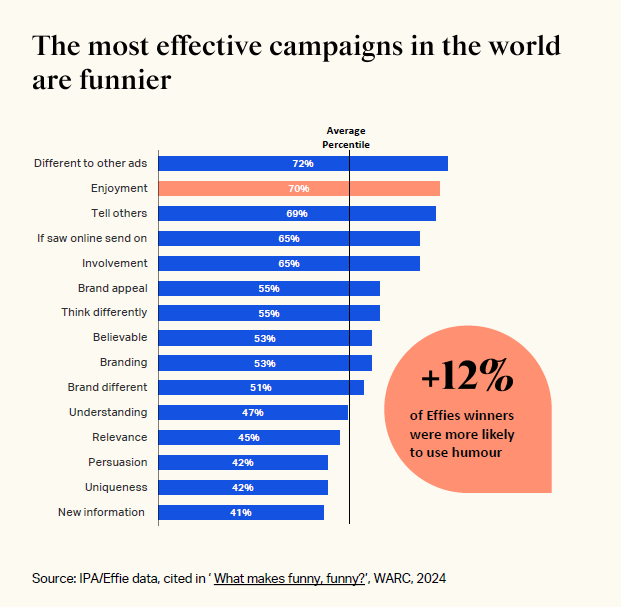Humour in advertising is so much more than just a wisecrack a brand expects its audience to laugh for 30 seconds about - it’s a strategic advantage. Yet, over the past two decades, humour in brand communication has been in decline, with marketers increasingly playing it safe. Given today’s fragmented attention spans, cautious brand environments, and a content-saturated world, is humour worth the risk? The answer, as we show in our latest report on humorous advertising, is a resounding yes!
 Source: warc.com / IPA
Source: warc.com / IPAThe power of laughter in brand building
Great advertising isn’t just seen; it’s remembered. And humour, as neuroscience confirms, acts as a “memory magnifier”, making ads more distinctive and long-lasting. Campaigns that evoke enjoyment consistently outperform those that don’t, with IPA and Effie-winning ads proving that humour is a common thread in effectiveness.
I like going back to ‘Ogilvy on Advertising’ every now and then. You probably do too. While David was perhaps, one might say, sceptical about humour, the “most successful ad-man of all time” didn’t dismiss it entirely. He mentioned that humour supports brand promise and enhances memorability when used correctly. This one sentence though has stayed with me since the first time I read the book. Not directly a reference to humour, but very relatable in this context – No idea is big unless it will work for 30 years. You only have to ask Specsavers how the brand keeps its idea fresh and funny for years. Or a shining example from my land – Fevicol. Needless to say, the brand is immortalised in the process. David would be proud.
That said, humour isn’t just a creative indulgence – it’s a commercial multiplier. Research shows that 72% of people would choose a brand that uses humour over one that doesn’t, yet only 33% of ads today can be described as “not overtly serious.” That’s a massive opportunity gap for brands willing to embrace humour as a strategic tool.
What makes humour work?
The best humorous campaigns aren’t just funny for the sake of it. They are rooted in deep consumer insight, cultural relevance, and brand authenticity. Consider Snickers’ You’re Not You When You’re Hungry – a campaign that used universal human behaviour to create global resonance. Or, yet again a recent Indian example, Vim’s Vim Black campaign, which turned gender stereotypes on their head with a satirical take on the way men view household chores.
Across markets, the way humour is used varies. In India and APAC, humour often taps into relatable, everyday scenarios – family dynamics, social hierarchies, or even the absurdity of daily life. Think Fevicol’s iconic ads or Spotify campaign in India, both of which transformed ordinary moments into comic gold. In contrast, Western markets tend to lean towards irony, self-deprecation, and sarcasm, as seen in campaigns from brands like Liquid Death or Old Spice.
The key? Make it real. Make it relatable. Make it memorable.
Where brands get it wrong
So why don’t more brands use humour? Fear of misinterpretation, concerns over cultural sensitivities, and the rise of cancel culture have made marketers hesitant. And yes, when humour goes wrong, the damage can be significant – think Pepsi’s infamous Kendall Jenner ad, which trivialised social justice movements.
But playing it too safe is an even bigger risk. Research shows that dull, forgettable advertising delivers significantly lower ROI. The real challenge isn’t whether to use humour – it’s about getting it right.
How brands can get it right
- Keep humour authentic to your brand: Forced or out-of-place humour can undermine credibility. If it doesn’t align with your brand’s voice, it won’t land.
- Tap into shared experiences: Humour that reflects universal truths or daily struggles resonates the most. Snickers’ hunger insight and Specsavers’ Should’ve Gone to Specsavers tagline are great examples.
- Use celebrities wisely: Pairing humour with celebrities can be a winning formula, as seen in Yorkshire Tea’s campaigns featuring Sean Bean and the Brownlee Brothers. But it must feel natural, not gimmicky.
- Understand cultural nuances: Humour is not universal. What works in Mumbai may not work in Manchester. Test and adapt humour for local contexts.
- Consistency is key: Brands that commit to humour long-term – like Old Spice or Fevicol or Specsavers – see compounding benefits in brand recall and affinity.
It’s time to stop playing safe
The ad industry is quick to talk about emotional storytelling but often forgets that humour is one of the strongest emotional triggers. It builds affinity, drives memorability, and enhances effectiveness.
In a landscape where consumers are skipping and scrolling past forgettable ads, laughter still remains the shortest distance between a brand and its audience. The question never will be whether humour still belongs in advertising, but are you as a marketer giving it a fair shot?
What’s working in humorous advertising’ presents the case for why humour in advertising remains relevant and effective. We hope you will find our report insightful and actionable.
Source: warc.com

